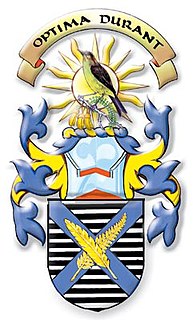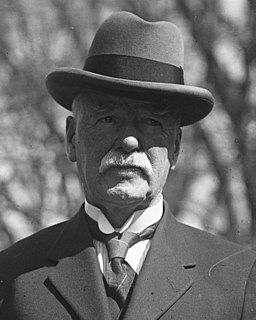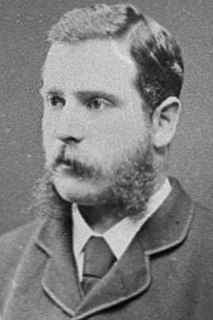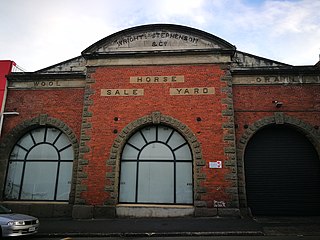
Timaru is a port city in the southern Canterbury region of New Zealand, located 157 km (98 mi) southwest of Christchurch and about 196 km (122 mi) northeast of Dunedin on the eastern Pacific coast of the South Island. The Timaru urban area is home to 28,600 people, and is the largest urban area in South Canterbury, and the second largest in the Canterbury Region overall, after Christchurch. The town is the seat of the Timaru District, which includes the surrounding rural area and the towns of Geraldine, Pleasant Point and Temuka, which combined have a total population of 48,400.

The Otago Daily Times (ODT) is a newspaper published by Allied Press Ltd in Dunedin, New Zealand. The ODT is one of the country's four main daily newspapers, serving the southern South Island with a circulation of around 43,000 and an estimated readership of 110,000. Founded in 1861 it is New Zealand's oldest surviving daily newspaper – Christchurch's The Press, six months older, was a weekly paper until March 1863.
The Kaitangata Line, also known as the Kaitangata Branch in its first years of operation, was a railway line in Otago, New Zealand. It was built by a private company and was later acquired by the government's Mines Department, and operated from 1876 until 1970. It provided a link from coal mines to the Main South Line, and was never integrated into the network managed by the New Zealand Railways Department, thus although it could be seen as a branch line of the Main South Line, it officially never was.

Allied Press is an independent New Zealand media and publishing company based in Dunedin. The company's main asset is the Otago Daily Times, New Zealand's oldest daily newspaper. Allied Press has a number of other daily and community newspapers and commercial printing operations throughout the South Island including the Canterbury–based media company Star Media. It also operates Dunedin's regional television station, Channel 39, on Freeview HD.

Sir William Jukes Steward was a New Zealand politician and the first Liberal Speaker of the New Zealand House of Representatives. He represented South Canterbury electorates in Parliament for a total of 34 years, before being appointed to the Legislative Council. He served briefly on the Otago Provincial Council and was Mayor of Oamaru for three years.

Sir George Fenwick was a New Zealand newspaper proprietor and editor. He is best known for his time as manager and editor of the Otago Daily Times, during which time he supported the campaign initiated by Rutherford Waddell against sweat shops.

Ritchies Transport was established in 1972 and describes itself on its website as "the largest privately owned bus and coach transport operator in New Zealand" with a fleet of "over 1500" vehicles spread across depots nationwide.
The Southern Festival of Speed was a classic and historic racing series held in the South Island in New Zealand. It started in the late 1980s with the revival of the 1950s Dunedin Street Circuit. It comprised rounds at three permanent circuits and one temporary Dunedin circuit. It was organised with assistance from various local car clubs that included the Otago Sports Car Club.

William Hort (Willie) Levin was a 19th-century merchant, philanthropist and politician who lived in Wellington, New Zealand.

Charles Thomas Ick was Mayor of Christchurch, New Zealand, from December 1878 to December 1880. Born in Shropshire, he learned the trade of a mercer and draper. The Icks had five children when they emigrated to Otago in 1858. He worked in his learned trade in Dunedin for five years before becoming a farmer in Waikouaiti for seven years. In 1870, he came to Christchurch and set himself up as an auctioneer and later opened a drapery business.

Edward Pearce was a leading merchant who based himself in Wellington, New Zealand from 1861 to 1899.

Charles Stephen Reeves was a prominent New Zealand businessman and former Mayor of Dunedin.
PGG Wrightson Limited is an agricultural supply business based in New Zealand. It was created in 2005 through the merger of Pyne Gould Guinness Ltd and Wrightson Limited and has its roots in a number of stock and station agencies dating back to 1861. It is one of the major suppliers to the agricultural sector in New Zealand providing products such as seeds, grains, livestock, irrigation, farm equipment, insurance and financing. Although publicly listed in New Zealand on the NZX, PGG Wrightson has been majority owned by Chinese-based Agria Corporation since 2011.

Sir William Duffus Hunt known before his knighthood as W D Hunt, was a leading New Zealand businessman of the first half of the 20th century. With his partner James Johnstone, he built one of Australasia's leading stock and station agencies, Wright Stephenson & Co.
Archibald Fotheringham Hawke was a businessman from Invercargill, and a member of the New Zealand Legislative Council from 1918 to 1932.

Wright Stephenson was a stock and station agency founded in Dunedin, New Zealand, in 1861.

Henry John Le Cren was a New Zealand merchant. Born in London, he was an early settler in Lyttelton and traded both in the port town and central Christchurch. He moved to Timaru in 1858 and is regarded as one of the town's pioneers. Companies owned by him or his eldest son are predecessors to the New Zealand agricultural supply business PGG Wrightson.

Murray Roberts & Co Limited owned a stock and station agency in New Zealand. For a time, it was New Zealand's largest wool exporter. Its business began in Green Island, Dunedin as a fellmongery owned by the Melbourne partners. Under direction of young John Roberts from 1867, it made very substantial investments in rural property in Otago and Hawke's Bay and spread as a stock and station agency through Otago and Southland and the lower half of the North Island.

Sir George Shirtcliffe was a New Zealand businessman and politician.















